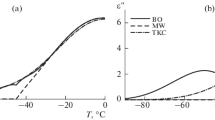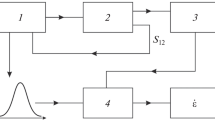Abstract
Loss factor of supercooled pore water is studied at frequencies of 60–140 GHz at temperatures of down to –70°C using silica gel. It is shown that, with disregard of the effect of monomolecular nonfreezing layer of bound water, the loss factor of pore water in the silicate material is determined by the Debye relaxation of water corresponding to the properties of bulk water, additional loss in a temperature interval centered at ‒45°C owing to the effect of the second critical point of water, and the surface conduction at the interface due to the formation of ferroelectric ice 0 provided that the freezing point of water in pores is lower than ‒23°C. The experimental results can be used in the problems of radiation transfer in aerosols and porous wetted finely dispersed media.



Similar content being viewed by others
REFERENCES
G. S. Bordonskii, A. O. Orlov, and Yu. B. Khapin, Sovrem. Probl. Distantsion. Zondir. Zemli iz Kosm. 14, 255 (2017).
T. Meissner and F. J. Wentz, IEEE Trans. Geosci. Remote Sens. 42, 1836 (2004).
S. M. Korobeynikov, A. V. Melekhov, Yu. G. Soloveitchik, et al., J. Phys. D: Appl. Phys. 38, 915 (2005).
G. S. Bordonskii, A. O. Orlov, and K. A. Shchegrina, Izv. Vyssh. Uchebn. Zaved. Radiofiz. 59, 906 (2016).
A. E. Basharinov and B. G. Kutuza, Tr. Glav. Geofiz. Observat., No. 222, 100 (1968).
A. E. Basharinov and B. G. Kutuza, Izv. Vyssh. Uchebn. Zaved. Radiofiz. 17, 52 (1974).
D. Bertolini, M. Cassettari, and G. Salvetti, J. Chem. Phys. 76, 3285 (1982).
C. Rønne, L. Thrane, P.-O. Åstrand, et al., J. Chem. Phys. 107, 5319 (1997).
H. R. Zelsmann, J. Mol. Struct. 350, 95 (1995).
G. Santachiara and F. Belosi, Atmospheric & Climate Sci. 4, 653 (2014).
H. E. Stanley, S. V. Buldyrev, G. Franzese, et al., Phys. A: Stat. Mech. Appl. 389, 2880 (2010).
D. T. Limmer and D. Chandler, J. Chem. Phys. 135, 134503 (2011).
A. B. Akvilonova and B. G. Kutuza, Radiotekh. Elektron. (Moscow) 23, 1792 (1978).
D. Rosenfeld and W. L. Woodley, Nature 405, 440 (2000).
V. A. Parshukov and B. G. Kutuza, J. Commun. Technol. Electron. 57, 117 (2012).
G. S. Bordonskii and S. D. Krylov, Zh. Fiz. Khimii A 86, 1806 (2012).
S. R.-V. Castrillon, N. Giovambattista, I. A. Arsay, and P. G. Debenedetti, J. Phys. Chem. C 115, 4624 (2011).
S. Cerveny, F. Mallamace, J. Swenson, et al., Chem. Rev. 116, 7608 (2016).
H. Haken, Synergetics (Springer-Verlag, Berlin, 1997; URSS, LENAND, Moscow, 2015), Pt. 1, 2.
G. S. Bordonskii, A. O. Orlov, and T. G. Filippova, Izv. Vyssh. Uchebn. Zaved. Radiofiz. 47, 292 (2004).
C. Mätzler, P. W. Rosenkranz, and J. Cermak, J. Geophys. Res. Atmos. 115 (D23), D23208 (2010).
C. Mätzler and U. Wegmuller, J. Phys. D: Appl. Phys. 20, 1623 (1987).
G. S. Bordonsky and S. D. Krylov, IEEE Trans. Geosci. Remote Sens. 36, 678 (1998).
Yu. I. Alekseev, Prib. Tekh. Eksp., No. 2, 177 (2008).
L. Xu, P. Kumar, S. V. Buldyrev, et al., Proc. Natl. Acad. Sci. USA 102, 16558 (2005).
M. A. Anisimov, Russ. J. Phys. Chem. B 6, 861 (2012).
G. S. Bordonskii and A. A. Gurulev, Tech. Phys. Lett. 43, 380 (2017).
C. A. Angell, W. J. Sichina, and M. Oguni, J. Phys. Chem. 86, 998 (1982).
P. O. Fedichev, L. I. Menshikov, G. S. Bordonskiy, and A. O. Orlov, JETP Lett. 94, 401 (2011).
J. Russo, F. Romano, and H. Tanaka, Nature Mater. 13, 733 (2014).
D. Quigley, D. Alfè, and B. Slater, J. Chem. Phys. 141, 161102 (2014).
G. S. Bordonskiy and A. O. Orlov, JETP Lett. 195, 492 (2017).
Sh. Fujita, T. Matsuoka, T. Ishida, et al., Physics of Ice Core Records (Hokkaido Univ., Sapporo, 2000).
V. I. Gaiduk and B. G. Kutuza, Opt. Spectroscopy 101, 698 (2006).
Author information
Authors and Affiliations
Corresponding author
Additional information
Translated by A. Chikishev
Rights and permissions
About this article
Cite this article
Bordonskii, G.S., Orlov, A.O. & Krylov, S.D. Analysis of Loss Factor of Supercooled Pore Water at Frequencies of 60–140 GHz. J. Commun. Technol. Electron. 64, 375–380 (2019). https://doi.org/10.1134/S1064226919040028
Received:
Revised:
Accepted:
Published:
Issue Date:
DOI: https://doi.org/10.1134/S1064226919040028




